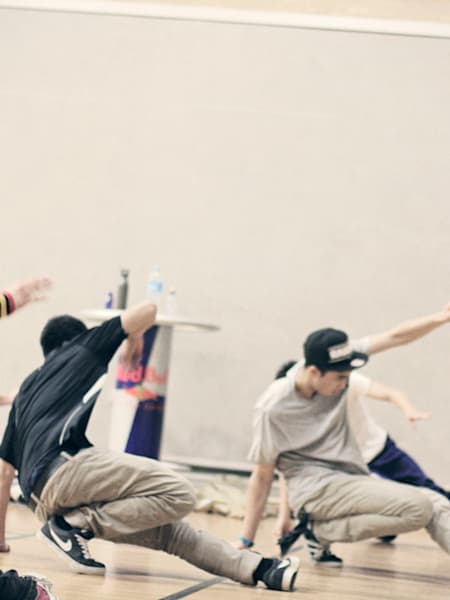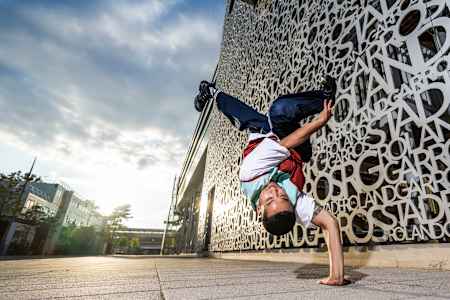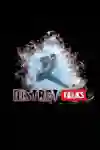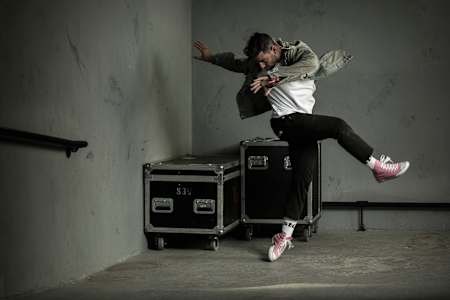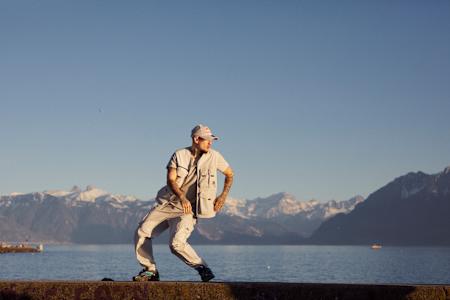Creating movement from scratch to encompass the feeling, rhythm, and theme of a song takes a little imagination and some work, whether dancers are beginners or getting ready for a big performance. Red Bull BC One All Star Hong 10 is always looking for ways to grow his dance choreography.
"Making new moves is always my favorite thing to do,” he says.
When including new movements and dance phrases for multiple performers, as Hong 10 does, coordinating dance choreography can get quite complicated. To help fix that, here’s some top pro tips on how to choreograph a dance when feeling stuck, including methods to step outside the box and spice up a routine.
01
Study the music
If a dancer knows what music they want to choreograph their dance to, they should start taking a closer look at every note. Go beyond creating movements based on the rhythm and beat of the song, and study the lyrics, the emotion, and the meaning behind it. They can find inspiration from the feelings they get when they read the words, and embrace the emotion the artist puts into the song as part of the dance.
Poppin' C, a Swiss popping dancer, says, "The music is everything for me, because the way my body adapts and moves, is because of the way I feel the music." By knowing every part of the music inside and out, dancers can design dance moves that work with the beat and lyrics.
B-boy Junior holds a breaking workshop at Red Bull BC One Camp in Mumbai
© Ali Bharmal / Red Bull Content Pool
02
Watch the pros
Take some time to watch dance-heavy musicals, like "Chicago" and "Anything Goes," competitive series like "World of Dance," and even street performers, like Logistx, to grab some inspiration for different moves. Observe the styles, transitions, and combinations of movements and note how pro dancers create a physical connection to the music.
Attend competitions like Red Bull Dance Your Style to watch the pros in person. This can help with inspiration when creating dances that get the audience to connect with their physical interpretations of the music.
03
Plan for audience and venue
Dancers should think about who their performance or event is for. Dancers also need to consider the venue where they're performing because the environment can help them find ways to express emotion creatively. Lighting, sound, and the overall ambiance of the venue can help choreograph dances that incorporate mood and emotion to connect with the audience during the performance.
04
Think about dance style
Choreograph with steps and dance moves that reflect a specific style. Choreographers might try incorporating hip-hop steps into a classical dance to mix it up and create your own unique dance style, for example. If a dancer is just starting out with dance choreography, they should try focusing on learning how to balance a specific style of dance with their unique interpretation of the music they're dancing to.
Kid David poses for a portrait at Red Bull Dance Your Style USA Finals
© Carlo Cruz/Red Bull Content Pool
05
Focus on the basic elements
Focus on one (or several) of the most basic elements of dance: shape, form, space, time, and energy. For form, dancers can focus on designing phrases and steps based on something from nature, like an animal or landform. Use a stage space to showcase explosive energy and give certain aspects of the performance a punch of emotion that keeps the audience engaged.
06
Don't start at the beginning
If someone is stuck trying to figure out how to start the dance, plan it out from the middle or from the end. Tell a story through your dance choreography and plan out the climatic elements before the small steps to help flesh out where to dance with certain ideas. Once the team has outlined the basic structure of the choreography, piece it together into an entire work.
07
Try choreographing without music
Dance in silence. It might seem like an outlandish idea since dancers typically choreograph to a specific song. However, just letting the body move and flow while imagining different tunes can help a dancer step outside their comfort zone. It’s a great way to incorporate challenging moves and dance steps that might not have been obvious to pair with a song or score. After discovering a move that works, try pairing it with other steps that are already developed and start fitting the moves to the music.
Poppin C shows off his moves during a photoshoot in Lausanne
© Torvioll Jashari / Red Bull Content Pool
08
Embrace post-modernism
Study early modern dance forms and styles that get the imagination flowing. Dancers from the mid-century modern era through the 1950s and '60s (such as Anna Halprin, one of post-modern dance's pioneers) would incorporate a whole world of nontraditional moves in their choreography. Slow walking, vocals, and even common gestures can make imaginative additions to the overall choreography.
09
Incorporate the classics
Use classical ballet, traditional ballroom steps, or other classic dance moves to mix up styles. It can be a startling transition for an audience to see a ballet step snapped in between freestyle moves. Combining classical techniques with your dance design can add interest and suspense to each performance.
10
Use other art forms as inspiration
Don't just focus on music and dance. Look at all kinds of art forms, from two-dimensional paintings to live art performances. Take note of the different emotions and use of space, shapes, and forms that different artworks incorporate. Think about how new interpretations can be conveyed in movement. Use this as fuel for inspiration when choreographing short phrases. Keep up to date on new forms of art to get inspired and avoid the dreaded writer's block (for dancers).
11
Focus on one section at a time
Instead of trying to create an entire routine at once, break the dance choreography into manageable sections. Focus on perfecting one portion of the dance before moving on to the next. This limitation lets dancers experiment with different movement ideas and improve specific moments without feeling overwhelmed by the entire project.
12
Take time for breaks
It’s easy to get stuck in a rut or feel mentally drained. Taking breaks can help reset the mind and allow ideas to simmer. Engage in a different activity or even go for a walk to help encourage a new perspective on the choreography. This break can give the brain time to process and bring fresh energy to the next rehearsal. Sometimes the best ideas come when a dancer isn’t actively working on the dance.
13
Explore improvisation
Incorporating improvisation into the dance choreography process can prevent being constrained by pre-planned movements. Freely moving to the music without predetermined steps can spark new ideas and inspire unexpected combinations of movement. After a free-form session, dancers can take the best moments and refine them into polished choreography.
Red Bull Dance Your Style Nigeria 2021 winner, Blayke, said improvisation and passion drive his freestyle dance moves. He likes to experiment with his body to see what he can do instead of focusing on trends.
14
Collaborate with others
Dance choreography doesn’t have to be a solo activity. Working with other dancers, choreographers, or even non-dancers can bring fresh ideas and perspectives. Collaborating allows dancers to combine different movement styles and approaches they might’ve not considered. Learning from others’ experiences and interpretations of movement is a great way to grow as a dancer.
15
Plan the time needed to complete the choreography
Create a schedule that divides the choreography sessions into different phases of the dance. Set clear goals, and have buffer time in case adjustments are needed. This can help keep the process organized and reduce last-minute stress to enjoy the creative process before any competitions or performances.
16
Record each practice session
Many dancers practice in front of a mirror to see their moves in action — and so they can see where improvement is needed. If a mirrored room isn’t available, record each movement. It’ll be available to watch on replay and easier to pinpoint the exact move that needs to be tweaked.
More Pro Tips to Choreograph a Dance
Arlene Phillips CBE, a British choreographer and theater director, got her start pro dancing and choreographing in the 1970s. She's been the choreographer for a variety of performances over the years, including live theater. Her advice for aspiring dancers includes some helpful choreographing tips:
- Tell the music's story through your movements
- Keep practicing with imaginative steps
- Be determined to learn from your mistakes
- Challenge yourself with unique rhythms, styles, and techniques
- Plan out your most impactful elements then work in additional steps around those
- Keep practicing your choreographing techniques
- Don't be afraid to learn something new
Unleash creativity by embracing diversity in dance
Diversity is the uniting thread through most of these tips. Try incorporating new styles or steps to make the dance fresh, and study all types of art to get excited about every type of work. The more dancers challenge themselves to think outside the box, the more creative and unique they can be with their choreography.

